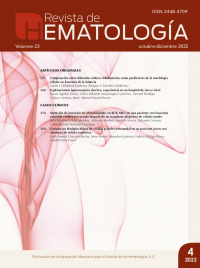Comparison among different inflammatory indices as predictors of cell morphology in childhood leukemia.
Rev Hematol Mex. 2022; 23 (4): 237-245. https://doi.org/10.24245/rev_hematol.v23i4.8381
Diana L Villalobos-Espinosa,1 Enrique A Sánchez-Valdivieso1,2
1 Departamento de investigación, Escuela de Medicina, Universidad Cristóbal Colón, Campus Calasanz, Boca del Río, Veracruz, México.
2 Hospital de Alta Especialidad de Veracruz, Secretaría de Salud, Veracruz, México.
Resumen
OBJETIVO: Determinar la utilidad de los índices neutrófilo-linfocito, plaqueta-linfocito, plaqueta-neutrófilo, monocito-neutrófilo, linfocito-monocito y volumen plaquetario medio como herramienta diagnóstica en leucemias linfoblásticas agudas infantiles.
MATERIALES Y MÉTODOS: Estudio observacional, transversal analítico, retrospectivo en el que de 2004 a 2018 se revisaron expedientes de pacientes pediátricos con leucemia linfoblástica aguda (LLA), dividiéndolos en dos grupos: LLA tipo L1 y LLA de morfología L2/L3. Se recabaron datos del hemograma y con ellos se calcularon y estudiaron los diferentes índices mediante curvas ROC para evaluar su utilidad como herramienta diagnóstica.
RESULTADOS: De 102 pacientes incluidos, 80 correspondían a LLA L1 y 22 a LLA L2/L3; el 45.1% eran mujeres. Mediante curvas ROC se determinó un área bajo la curva para índice linfocito-monocito de 0.572 y se obtuvo sensibilidad del 63.8% y especificidad del 63.6% para el diagnóstico presuntivo de LLA L1.
CONCLUSIONES: El índice linfocito-monocito resultó ser el mejor para diagnóstico de presunción en leucemias linfoblásticas agudas infantiles tipo L1.
PALABRAS CLAVE: Leucemia linfoblástica aguda; niños.
Abstract
OBJECTIVE: To determine the usefulness of the neutrophil-lymphocyte, platelet-lymphocyte, platelet-neutrophil, monocyte-neutrophil, lymphocyte-monocyte and mean platelet volume indices as a diagnostic tool in childhood acute lymphoblastic leukemia.
MATERIALS AND METHODS: Observational, analytical cross-sectional, retrospective study was done including records of pediatric patients with acute lymphoblastic leukemia (ALL), dividing them into two groups: carriers of ALL type L1 and ALL with L2/L3 morphology. Blood count data were collected and with them the different indices were calculated and studied using ROC curves to assess their usefulness as a diagnostic tool.
RESULTS: Of a total of 102 patients, 80 corresponded to ALL L1 and 22 to ALL L2/L3; 45.1% were women. Using ROC curves, an area under the curve for lymphocyte-monocyte index of 0.572 was determined and a sensitivity of 63.8% and a specificity of 63.6% were obtained for the presumptive diagnosis of ALL L1.
CONCLUSIONS: The lymphocyte-monocyte index turned out to be the best for presumptive diagnosis of childhood acute lymphoblastic leukemia type L1.
KEYWORDS: Acute lymphoblastic leukemia; Childhood.
Recibido: septiembre 2022
Aceptado: noviembre 2022
Este artículo debe citarse como: Villalobos-Espinosa DL, Sánchez-Valdivieso EA. Comparación entre diferentes índices inflamatorios como predictores de la morfología celular en leucemia de la infancia. Hematol Méx 2022; 23 (4): 237-245.

